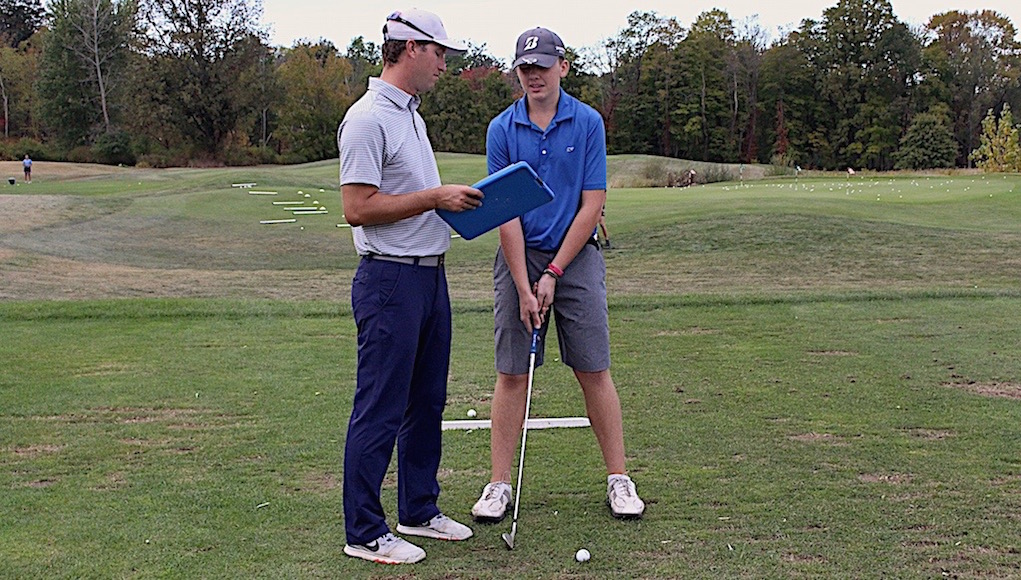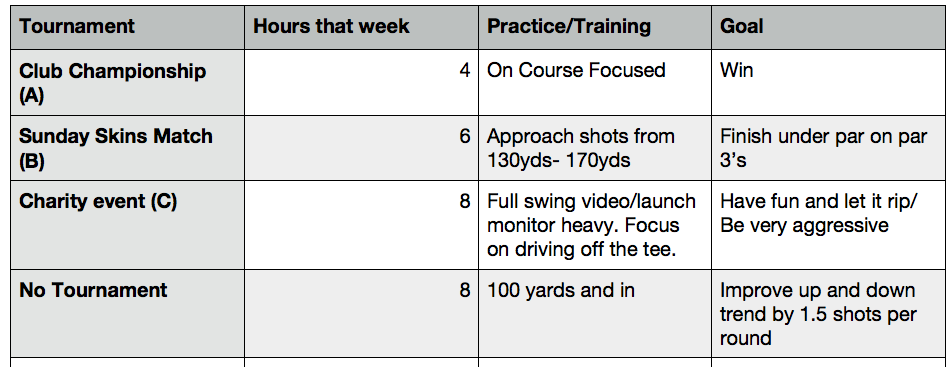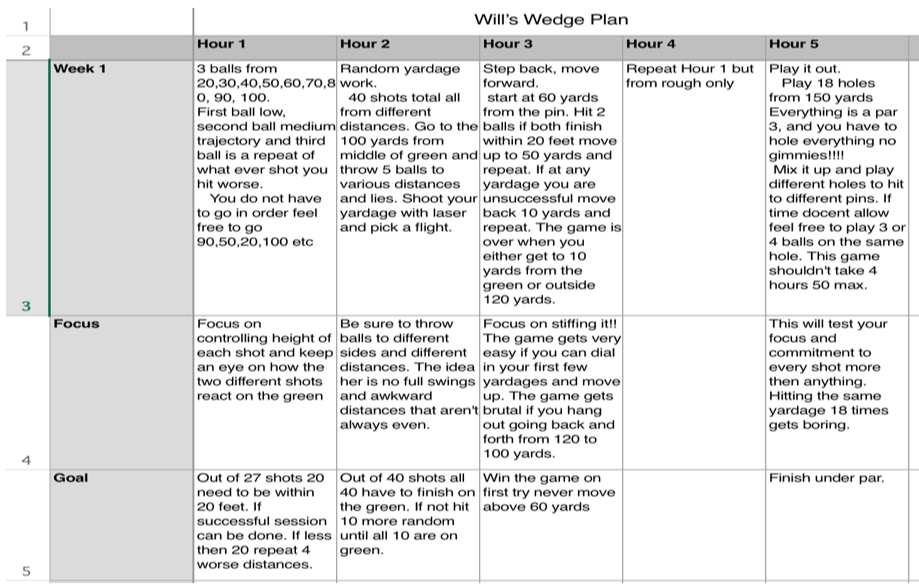Instruction
How to Build a Golf Training Plan

Walk the range at any course in the country, and I would be willing to bet that the majority of players hitting balls do not use a training plan. It’s like going into the gym everyday without a plan of what you want to accomplish. You’ll probably get stronger, but you won’t reach your potential.
When developing your golf training plan, you have to start with some very basic questions:
1. What is my ultimate goal for this plan? Don’t be afraid to dream here. Make your goal realistic, but if it’s not a little scary, it’s probably not big enough.
2. How much time can I realistically devote every week to my plan? You don’t want to stretch what’s possible with this answer. Be brutally honest with yourself. There is nothing worse then having a great plan, but not being able to make it work due to time constraints.
3. How can I measure my success? I like to use software like measuredpractice.com
4. What parts of my game need the most work? Again, stat-tracking software is invaluable for questions like this. The Shot by Shot app also does an incredible job pointing out deficiencies and strengths.
5. How will I stay accountable? It’s great to have a coach, a training partner, or a social media group to motivate you, follow your progress, and keep you accountable. Setting up a support system is key.
Once you have the time to sit down and write out the answers to those five questions, you are ready to start making your plan. And every week of your plan needs to have a goal and a weekly focus that fits into your ultimate goals.
In the picture above, you can see the player told me he could dedicate 5 hours a week to serious practice. That doesn’t mean he only played 5 hours of golf that week, but he had to have 100-percent focus for at least these 5 hours. This particular week’s focus and goal was all wedge work, which we chose as an area of focus based on the stats we had gathered. It fit into our game plan of hitting more drivers off the tee. This particular player can hit his driver in excess of 320 yards, so a sharper wedge game is key to helping him shoot lower his scores.

When I’m developing training plans with golfers, I like to create mini training plans with an even greater focus on a particular area. For instance, in setting up this player’s tournament schedule, we labeled tournaments A, B, or C. The “A” tournaments are the biggest and most important, while the “C” tournaments are less important or have weaker fields. Labeling the schedule allows us to determine in advance how much practice and training we will use, as well as what type of practice and training we will use.
In this example, the golfer was a scratch who mainly played club events. He told me that 8 hours per week was the most he could dedicate to practice time. So during the week with no tournament and the week with only a charity event, we used that full 8 hours to really focus on some technique and weaknesses in his game. As we moved into tournament weeks (A and B events), we used spent more time on mental focus and on-course practice to make sure he was prepared to shoot the lowest scores possible.
The hardest part of making a program is that you have to be willing to adapt and change. Most people can set up a very good plan, but as their game develops or as life happens, they fail to adjust their plan. This is where having a coach who can look at the big picture and the stats is invaluable. Looking at the big picture, a coach can take a step back and adjust the plan to suit both your short-term and long-term needs.
If you want to play your best golf possible, take the time to sit down and create a plan before your next round or range session. Enjoy the journey of improvement, and don’t hesitate to reach out for help as your goals need to be adjusted. We’re in this together!
- LIKE63
- LEGIT15
- WOW4
- LOL5
- IDHT4
- FLOP5
- OB5
- SHANK13
Instruction
Clement: Laid-off or perfect fade? Across-the-line or perfect draw?

Some call the image on the left laid off, but if you are hitting a fade, this could be a perfect backswing for it! Same for across the line for a draw! Stop racking your brain with perceived mistakes and simply match backswing to shot shape!
- LIKE0
- LEGIT0
- WOW0
- LOL0
- IDHT0
- FLOP0
- OB0
- SHANK1
Instruction
The Wedge Guy: The easiest-to-learn golf basic

My golf learning began with this simple fact – if you don’t have a fundamentally sound hold on the golf club, it is practically impossible for your body to execute a fundamentally sound golf swing. I’m still a big believer that the golf swing is much easier to execute if you begin with the proper hold on the club.
As you might imagine, I come into contact with hundreds of golfers of all skill levels. And it is very rare to see a good player with a bad hold on the golf club. There are some exceptions, for sure, but they are very few and very far between, and they typically have beat so many balls with their poor grip that they’ve found a way to work around it.
The reality of biophysics is that the body moves only in certain ways – and the particulars of the way you hold the golf club can totally prevent a sound swing motion that allows the club to release properly through the impact zone. The wonderful thing is that anyone can learn how to put a fundamentally sound hold on the golf club, and you can practice it anywhere your hands are not otherwise engaged, like watching TV or just sitting and relaxing.
Whether you prefer an overlap, interlock or full-finger (not baseball!) grip on the club, the same fundamentals apply. Here are the major grip faults I see most often, in the order of the frequency:
Mis-aligned hands
By this I mean that the palms of the two hands are not parallel to each other. Too many golfers have a weak left hand and strong right, or vice versa. The easiest way to learn how to hold the club with your palms aligned properly is to grip a plain wooden ruler or yardstick. It forces the hands to align properly and shows you how that feels. If you grip and re-grip a yardstick several times, then grip a club, you’ll see that the learning curve is almost immediate.
The position of the grip in the upper/left hand
I also observe many golfers who have the butt of the grip too far into the heel pad of the upper hand (the left hand for right-handed players). It’s amazing how much easier it is to release the club through the ball if even 1/4-1/2″ of the butt is beyond the left heel pad. Try this yourself to see what I mean. Swing the club freely with just your left hand and notice the difference in its release from when you hold it at the end of the grip, versus gripping down even a half inch.
To help you really understand how this works, go to the range and hit shots with your five-iron gripped down a full inch to make the club the same length as your seven-iron. You will probably see an amazing shot shape difference, and likely not see as much distance loss as you would expect.
Too much lower (right) hand on the club
It seems like almost all golfers of 8-10 handicap or higher have the club too far into the palm of the lower hand, because that feels “good” if you are trying to control the path of the clubhead to the ball. But the golf swing is not an effort to hit at the ball – it is a swing of the club. The proper hold on the club has the grip underneath the pad at the base of the fingers. This will likely feel “weak” to you — like you cannot control the club like that. EXACTLY. You should not be trying to control the club with your lower/master hand.
Gripping too tightly
Nearly all golfers hold the club too tightly, which tenses up the forearms and prevents a proper release of the club through impact. In order for the club to move back and through properly, you must feel that the club is controlled by the last three fingers of the upper hand, and the middle two fingers of the lower hand. If you engage your thumbs and forefingers in “holding” the club, the result will almost always be a grip that is too tight. Try this for yourself. Hold the club in your upper hand only, and squeeze firmly with just the last three fingers, with the forefinger and thumb off the club entirely. You have good control, but your forearms are not tense. Then begin to squeeze down with your thumb and forefinger and observe the tensing of the entire forearm. This is the way we are made, so the key to preventing tenseness in the arms is to hold the club very lightly with the “pinchers” — the thumbs and forefingers.
So, those are what I believe are the four fundamentals of a good grip. Anyone can learn them in their home or office very quickly. There is no easier way to improve your ball striking consistency and add distance than giving more attention to the way you hold the golf club.
More from the Wedge Guy
- The Wedge Guy: Golf mastery begins with your wedge game
- The Wedge Guy: Why golf is 20 times harder than brain surgery
- The Wedge Guy: Musings on the golf ball rollback
- LIKE88
- LEGIT13
- WOW6
- LOL1
- IDHT0
- FLOP4
- OB1
- SHANK8
Instruction
Clement: Stop ripping off your swing with this drill!

Not the dreaded headcover under the armpit drill! As if your body is defective and can’t function by itself! Have you seen how incredible the human machine is with all the incredible feats of agility all kinds of athletes are accomplishing? You think your body is so defective (the good Lord is laughing his head off at you) that it needs a headcover tucked under the armpit so you can swing like T-Rex?
- LIKE0
- LEGIT2
- WOW2
- LOL0
- IDHT0
- FLOP0
- OB0
- SHANK2
-

 19th Hole3 weeks ago
19th Hole3 weeks agoDave Portnoy places monstrous outright bet for the 2024 Masters
-

 19th Hole6 days ago
19th Hole6 days agoJustin Thomas on the equipment choice of Scottie Scheffler that he thinks is ‘weird’
-

 19th Hole3 weeks ago
19th Hole3 weeks agoTiger Woods arrives at 2024 Masters equipped with a putter that may surprise you
-

 19th Hole6 days ago
19th Hole6 days ago‘Absolutely crazy’ – Major champ lays into Patrick Cantlay over his decision on final hole of RBC Heritage
-

 19th Hole2 weeks ago
19th Hole2 weeks agoTwo star names reportedly blanked Jon Rahm all week at the Masters
-

 19th Hole2 weeks ago
19th Hole2 weeks agoReport: LIV Golf identifies latest star name they hope to sign to breakaway tour
-

 19th Hole2 weeks ago
19th Hole2 weeks agoNeal Shipley presser ends in awkward fashion after reporter claims Tiger handed him note on 8th fairway
-

 19th Hole2 weeks ago
19th Hole2 weeks agoBrandel Chamblee has ‘no doubt’ who started the McIlroy/LIV rumor and why

















robert
Oct 14, 2017 at 12:40 am
great read, a trainer makes me this plan…i’m wondering what would be if i had tjis 10 years ago…
Golf Doktor
Oct 14, 2017 at 5:52 pm
Yeah, but just reading a ‘plan’ won’t make you a better golfer. You gotta exercise so you’re physically fit and then train for golf….. a minimum 2 year plan.
Alternatively, you can read golf magazines, books and websites for really great golf ‘tips’…. and that should be enough for instant results… but only if you can think your way through your new golf swing.
M. Vegas
Oct 12, 2017 at 6:57 pm
Take a week or two off….
Then quit playing
Golf Doktor
Oct 14, 2017 at 5:53 pm
I hear that Texas Holdem Poker is really popular with high handicap golfers nowadays.
Golf Doktor
Oct 14, 2017 at 6:15 pm
No no, don’t quit playing!
The PGA defines a “golfer” as anybody who owns a set of golf clubs and plays once a year.
According to golf industry statistics there are ~50 million golfer worldwide…. and about 90% fall into the above category.
SteveK
Oct 11, 2017 at 6:34 pm
Any athletic training program must start with General Conditioning which means going to the gym and building up your body to control your body joints when under athletic stress. If you have weak abs or quads no amount of training for golf will help you because your weaknesses will ruin you.
You can have a basic home gym with weights and equipment or go to a health club for more equipment. It’s a cheap investment and one year of General Conditioning will pay tremendous dividends.
The next step is Sport-specific Training once you have reached an adequate level of General Conditioning. This may or may not include swinging a golf club. Simply skipping the General Conditioning is cheating and deluding. You can’t build a solid swing into a deficient body.
Sorry for the bad brutal truth, because attempting to tinker and patch a golf swing in the hope of improving your swing problems is plainly wrong.